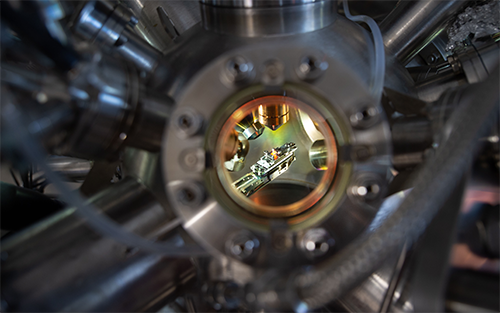| Sep 15, 2021 |
Crystal islands could halve time and cost of science experiments
(Nanowerk News) Queensland University of Technology (QUT) researchers have found a way to grow crystal islands that could halve the time and cost of some science experiments.
|
|
Dr Vishakya Jayalatharachchi, Associate Professor Jennifer MacLeod and Associate Professor Josh Lipton-Duffin from QUT Centre for Materials Science and QUT School of Chemistry and Physics published their findings in the Journal of Physical Chemistry C ("Metal Microsubstrates on Si(111): Crystallography, Morphology, and Interactions with a Molecular Adsorbate").
|
 |
| Silicon sample cleaned with high temperature. (Image: QUT)
|
|
“We grew two different types of silver crystal islands on the same silicon surface and were able to simultaneously use them to investigate molecular adsorbates—molecules that we stick to the surface,” Associate Professor MacLeod said.
|
|
“It does better than cutting experimentation time in half and has the advantage of ensuring that our conditions are identical for two simultaneous experiments, removing uncertainty from interpretation.
|
|
“Our study focused on silver because it is so useful for surface science experiments, but it's likely that we could see a similar result with other metals.”
|
|
Surface science explores physical and chemical reactions of gases and liquids on solids and is important for making semiconductors used in computers, mobile phones and other electronics.
|
|
It led to the process that produced ammonia for fertiliser used in agriculture, the development of better catalysts for chemical processing, and has advanced our understanding of batteries.
|
|
Associate Professor Josh Lipton-Duffin said, on average, surface science experiments could take between several hours to many days and can cost between $5,000 and $50,000.
|
|
“Time and cost of experimentation depends on the personnel, type of facility being used, and the cost of the consumables involved,” he said.
|
|
Dr Jayalatharachchi said growing crystal islands on metal surfaces was not new, but the researchers had found a way to increase island size and height which led to many benefits.
|
|
“Larger crystal islands grown on silicon have physical and chemical properties identical to the individual single crystals of pure metal.
|
|
“So, we can study reactions with pure metal without having to use pure metal, making experiments cheaper and faster,” she said.
|
|
Dr Jayalatharachchi said the bigger islands, while still microscopic, were also visible with more common lower tech optical microscopes, making them easier to locate and investigate.
|
|
Associate Professor Lipton-Duffin said their findings would also allow researchers to study approaches for constructing low dimensional networks to advance micro- and nanoelectronics.
|
|
“Using surface-confined reactions we can potentially create a whole host of graphene-like materials with additional properties such as electronic gaps, select gas sensitivity, or functional biological sensitivity encoded into the molecular building blocks,” he said.
|

